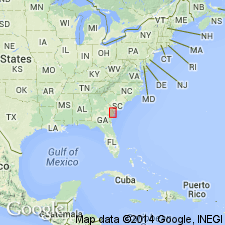
- Usage in publication:
-
- Wolf Pit Dolomite
- Modifications:
-
- First used
- Dominant lithology:
-
- Dolomite
- AAPG geologic province:
-
- South Georgia sedimentary province
Summary:
Name Wolf Pit Dolomite credited to Huddlestun (in press). Occurs in Alum Bluff 1 core, Liberty Co., FL, where it occupies interval from 357 ft to 371.5 ft. Also occurs in Mobley Plant Farm core, Colquitt Co., southwestern GA, according to figure 4. Unit not described in this report. Underlies Okapilco Member of Suwannee Limestone and overlies Ochlockonee Formation (both first used). Age is Oligocene.
Source: GNU records (USGS DDS-6; Reston GNULEX).

- Usage in publication:
-
- Wolf Pit Dolostone
- Modifications:
-
- Named
- Dominant lithology:
-
- Dolostone
- AAPG geologic province:
-
- South Georgia sedimentary province
Summary:
Wolf Pit Dolostone, here named, is a sucrosic, tan to brown dolostone with minor calcitic intervals confined to the Gulf Trough in GA and extends from at least Colquitt Co. in the southwest to Coffee Co. in the northeast. It has been tentatively identified in Grady Co., which borders FL, but the southwestern limit of the unit is unknown. It has not been reported from Gadsden or Jackson Cos., FL, and though shown in Alum Bluff core, Liberty Co., FL, in Bryan (1993), the author states here that the Alum Bluff core did not penetrate to the projected depth of the Wolf Pit Dolostone. Type section is designated in Colquitt Co., Core Colquitt 5, where thickness is 71 ft and a reference section is described as the core Coffee 4 (GGS-3541), interval 675 to 700 ft. Lithologically similar to the Suwannacoochee Dolostone (new), which occurs at higher elevations on the continental shelf south of the Gulf Trough. Unit gradationally overlies the Ochlockonee Formation (new) and abruptly underlies the Okapilco Limestone (new). Deposited during unusual low stand of the sea. Age cannot be paleontologically determined as all known fossils are very poorly preserved molds and casts. Its early Oligocene (late Vicksburgian, late Rupelian) age is based on its stratigraphic position above the Ochlockonee Formation, which has been correlated with the Suwannee Limestone and the Byram Formation.
Source: GNU records (USGS DDS-6; Reston GNULEX).
For more information, please contact Nancy Stamm, Geologic Names Committee Secretary.
Asterisk (*) indicates published by U.S. Geological Survey authors.
"No current usage" (†) implies that a name has been abandoned or has fallen into disuse. Former usage and, if known, replacement name given in parentheses ( ).
Slash (/) indicates name conflicts with nomenclatural guidelines (CSN, 1933; ACSN, 1961, 1970; NACSN, 1983, 2005, 2021). May be explained within brackets ([ ]).

